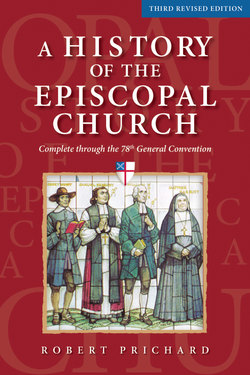Читать книгу A History of the Episcopal Church (Third Revised Edition) - Robert W. Prichard - Страница 10
На сайте Литреса книга снята с продажи.
ОглавлениеPreface to the First Edition
A quarter century has now passed since the publication of the last general history of the Protestant Episcopal Church.2 The mere passage of time—twenty-five years of rapid change that have brought the ordination of women to the presbyterate and episcopate, the Charismatic movement, a rise in Hispanic membership, the publication of a hymnal and a prayer book, and the first meaningful level of racial integration—is a sufficient cause for a new look at the subject. Yet, there are other reasons as well for a new study. A flowering of new scholarship has called attention to the roles of women, minorities, and the laity in the church that had often been overlooked in previous accounts. The continuing ecumenical dialogue in which the Episcopal Church has been involved in this century underlined the importance of relating the story of the Episcopal Church to that of other American denominations. Historians with an interest in social context have provided clues to the social context in which Episcopalians lived.3 In addition, a series of recent period studies have provided new insights into ways of approaching the general story of the Episcopal Church.4
These and many other questions have influenced the way in which I have shaped the narrative that follows. It differs therefore from the histories of the Episcopal Church that have preceded it in a number of ways. I would, however, like to draw attention to five particular elements. First, I have attempted to broaden the base of the story to be more inclusive of laypersons, females, blacks, Hispanics, Asian Americans, and the deaf. In large measure, I am relying on the excellent scholarship of others in this area.5 Second, I have come to believe that an understanding of the apostolic succession-baptismal covenant argument (the belief that ordination by bishops is a necessary part of the relationship into which God draws the redeemed at baptism) provides a key to understanding many Anglican attitudes from 1700 to the end of the nineteenth century. I have used the concept in my explanation of the success of the Society for the Propagation of the Gospel in New England, of the shock caused during the Awakening by George Whitefield (who rejected the argument as invalid), and of the crisis produced by a growing Roman Catholic Church (which also had apostolic succession) in the nineteenth century.6 I believe the concept is also useful in understanding the relationship of the Episcopal Church to other denominations.
Third, my reading of the correspondence between Anglican clergy and England during the Great Awakening that is contained in the Fulham Papers has led me to suggest a new model for the understanding of the Great Awakening. Previous historians have wrestled with the mixed response that George Whitefield received from his coreligionists in the colonies. I have used a chronological device—differentiating a negative response up to 1759 and an increasingly positive one after that date—to make sense of this data. I believe that this approach allows both for a clearer description of the relationship between Episcopalians and Methodists and for the incorporation of more information about lay piety.
Fourth, the passage of time has allowed me, I think, to take a new look at the 1920s. Those historians who wrote in the thirties and forties played down the divisions in the church at that time.7 I have, in contrast, called attention to the effects of the modernist-fundamentalist debate in the church and have noted the lack of agreement on such basic issues as rights of female and black Episcopalians. Fifth, I have, in addition, continued the narrative to 1990.
I thank all of those who have helped me with this work, particularly, Marcia, Daniel, and Joseph, my patient wife and sons; Guy F. Lytle, Samuel Garrett, Bruce Mullin, Roland Foster, and Charles Henery, fellow historians who have given me advice and counsel at various points; the members of the Women’s History Project, who have taught me to look at historical evidence in new ways; and a decade of students at the Virginia Theological Seminary, who have taken my class in the history of the Episcopal Church.
Robert W. Prichard
Alexandria, Virginia
January 1991
